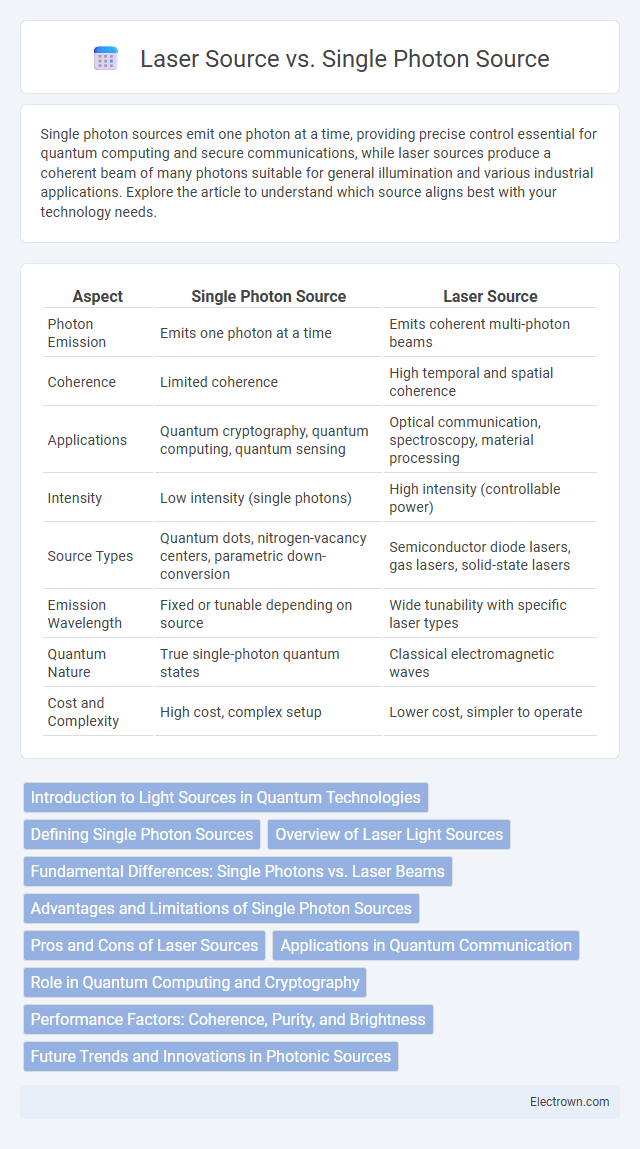Single photon sources emit one photon at a time, providing precise control essential for quantum computing and secure communications, while laser sources produce a coherent beam of many photons suitable for general illumination and various industrial applications. Explore the article to understand which source aligns best with your technology needs.
Table of Comparison
| Aspect | Single Photon Source | Laser Source |
|---|---|---|
| Photon Emission | Emits one photon at a time | Emits coherent multi-photon beams |
| Coherence | Limited coherence | High temporal and spatial coherence |
| Applications | Quantum cryptography, quantum computing, quantum sensing | Optical communication, spectroscopy, material processing |
| Intensity | Low intensity (single photons) | High intensity (controllable power) |
| Source Types | Quantum dots, nitrogen-vacancy centers, parametric down-conversion | Semiconductor diode lasers, gas lasers, solid-state lasers |
| Emission Wavelength | Fixed or tunable depending on source | Wide tunability with specific laser types |
| Quantum Nature | True single-photon quantum states | Classical electromagnetic waves |
| Cost and Complexity | High cost, complex setup | Lower cost, simpler to operate |
Introduction to Light Sources in Quantum Technologies
Single photon sources emit individual photons with precise quantum states, essential for quantum cryptography and quantum computing, ensuring secure and efficient information transfer. Laser sources produce coherent light with many photons, widely used for classical communication, sensing, and optical manipulation but lack the quantum-level control required for advanced quantum applications. Quantum technologies demand single photon sources for their ability to generate on-demand, indistinguishable photons crucial for entanglement and quantum interference experiments.
Defining Single Photon Sources
Single photon sources emit one photon at a time, crucial for quantum cryptography and quantum computing applications, whereas laser sources generate coherent light with multiple photons simultaneously. Single photon sources utilize phenomena like quantum dots, color centers in diamonds, or parametric down-conversion to achieve on-demand photon emission with high purity. Laser sources provide high-intensity, continuous wave or pulsed beams ideal for spectroscopy and communications but lack the discrete photon emission essential for quantum technologies.
Overview of Laser Light Sources
Laser light sources emit coherent, monochromatic beams generated through stimulated emission, commonly used in applications requiring high intensity and directionality. Unlike single photon sources, lasers produce a multitude of photons simultaneously, making them ideal for tasks such as optical communication, cutting, and imaging. Their operation typically involves a gain medium, optical cavity, and external excitation to achieve population inversion and sustained light amplification.
Fundamental Differences: Single Photons vs. Laser Beams
Single photon sources emit individual photons one at a time, ensuring quantum-level precision essential for applications like quantum cryptography and quantum computing, whereas laser sources produce coherent beams consisting of millions of photons with identical phase and frequency. The fundamental difference lies in photon statistics: single photon sources exhibit antibunching behavior with Poissonian statistics, contrasting with the coherent state of laser beams that follow a Poisson distribution but allow multi-photon emissions. Understanding these distinctions helps optimize Your system for secure quantum communication or high-resolution imaging by selecting the appropriate photon source.
Advantages and Limitations of Single Photon Sources
Single photon sources offer precise control over photon emission, enabling secure quantum communication and advanced quantum computing applications by producing one photon at a time with high purity. Their advantages include reduced noise and improved information security compared to laser sources, which emit coherent light with many photons simultaneously. Limitations of single photon sources involve lower brightness, complex fabrication, and challenges in integration with existing optical systems, impacting their scalability and practical deployment.
Pros and Cons of Laser Sources
Laser sources offer high brightness and coherence, making them ideal for applications requiring intense, focused light such as material processing and optical communication. However, laser sources emit multiple photons simultaneously, which limits their use in quantum cryptography and single-photon experiments due to reduced security and precision. Their relatively simple implementation and cost-effectiveness contrast with the complexity and expense of single photon sources, which provide true single-photon emission for advanced quantum technologies.
Applications in Quantum Communication
Single photon sources are essential for secure quantum communication protocols such as quantum key distribution (QKD) because they emit individual photons, minimizing the risk of eavesdropping. Laser sources, while more widely available and capable of producing high-intensity light pulses, lack the ability to guarantee single-photon emission, making them less secure for certain quantum communication applications. Your choice of source directly impacts the security level and efficiency of quantum networks, with single photon sources offering superior performance in maintaining quantum state integrity over long distances.
Role in Quantum Computing and Cryptography
Single photon sources provide true quantum states essential for advanced quantum computing algorithms and secure quantum key distribution, offering unparalleled resistance to eavesdropping. Laser sources emit coherent light with multiple photons, limiting their effectiveness in protocols requiring discrete quantum states and increasing vulnerability to interception. The precision and determinism of single photon sources enable reliable qubit manipulation and encryption, fundamentally enhancing quantum cryptographic systems.
Performance Factors: Coherence, Purity, and Brightness
Single photon sources offer superior purity with near-ideal single-photon emission, minimizing multi-photon events, while laser sources produce coherent light with high brightness but exhibit Poissonian photon statistics. Coherence length in laser sources is significantly longer, enabling stable phase properties, whereas single photon sources often have limited coherence due to their quantum dot or atomic emitter characteristics. Brightness in lasers is generally higher, but single photon sources optimize photon indistinguishability and anti-bunching essential for quantum communication and computing applications.
Future Trends and Innovations in Photonic Sources
Future trends in photonic sources emphasize the development of single photon sources with enhanced purity, indistinguishability, and on-demand generation capabilities, crucial for quantum communication and computing. Innovations in laser sources focus on tunable, ultrafast pulses with higher coherence and lower noise for applications in spectroscopy and precision measurements. Integration of nanophotonic structures and novel materials like quantum dots and 2D semiconductors is driving the miniaturization and efficiency of both single photon and laser sources.
single photon source vs laser source Infographic

 electrown.com
electrown.com